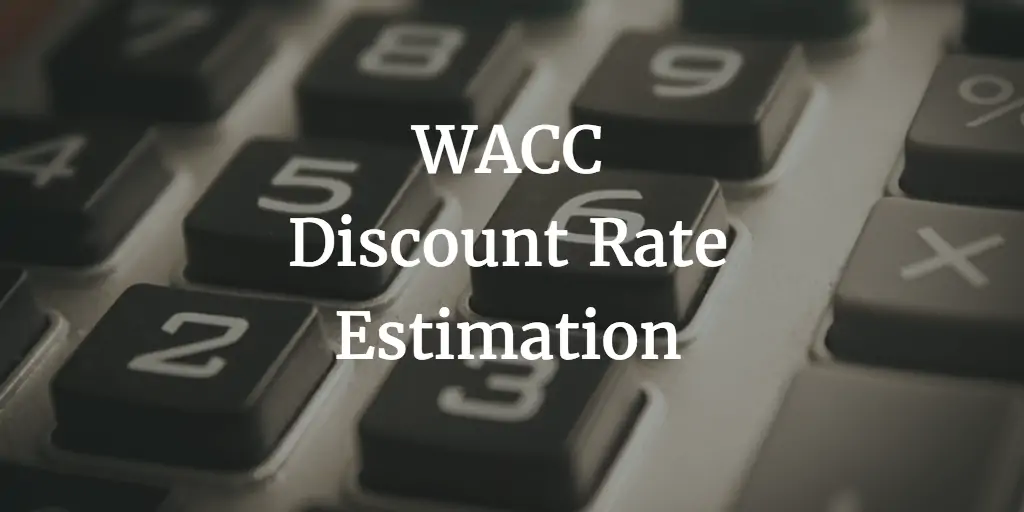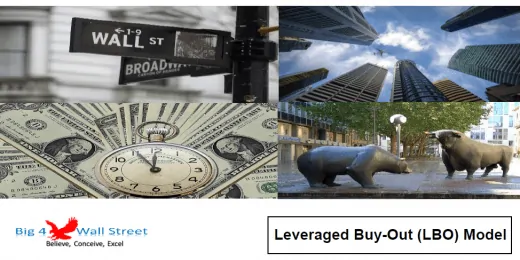How to Calculate the Weighted Average Cost of Capital (WACC)

What is WACC?
The Weighted Average Cost of Capital (WACC) is a method to estimate the Discount Rate (or its cost of capital) for an asset or a company by analyzing the target financing structure of equity and debt and their cost of capital. The WACC will then calculate the weighted average of the cost of capital. The WACC represents the opportunity cost of capital to invest in assets or companies at similar risk at market terms and reflects the required return to compensate capital providers such as shareholders and creditors.
Shareholders calculate the cost of their equity by using the Capital Asset Pricing Model (CAPM). The model adds an equity premium to a risk-free return to compensate investors for the risk. The Equity premium depends on the Market Premium and the expected correlation between the asset and the stock market (the Beta). The use of leverage typically impacts the beta. Therefore, we differentiate between levered and unlevered beta.
The cost of debt usually considers the risk from a creditor’s perspective but is adjusted for the tax rate as a company can deduct interest from the taxable profits to its benefit.
WACC is one of the most widely used methods in finance to estimate the discount rate in the analysis of the Net Present Value (NPV) of future cash flows.
The WACC reflects the opportunity cost of capital; if the capital would be invested at market terms, the resulting return would be the same as the WACC. It reflects the riskiness of a business or an asset; the higher the risk, the higher the WACC and vice versa.
The WACC Formula in Short
Here’s an overview of the WACC formula.
WACC = (Equity Share % x Cost of Equity) + ((Debt Share % x Cost of Debt) x (1 – Tax Rate))
In short, it means we assume a certain target financing structure of debt and equity capital at which a company should be financed. Then we calculate the weighted average cost of capital by weighting the Cost of Equity and the Cost of Debt. The more scientific version of the WACC equation is this one:
WACC = (E/V x COE) + ((D/V x COD) x (1 – T))
Whereas:
- E = Market value of the equity capital
- V = Total capitalization (equity plus debt at market values)
- COE = Cost of Equity
- D = Market value of debt capital
- COD= Cost of Debt
- T = Tax rate
- E/V = Equity-to- total capitalization ratio
- D/V = Debt to total capitalization ratio
Let us now break down the WACC equation into its components and explain it in layman’s terms.
How to find the WACC?
Although the standard WACC formula appears to be complex, if you have all the necessary information, it is not difficult to compute WACC. How to calculate it is relatively simple.
For example, a company has the following data for us to calculate its WACC:
- Debt: Total Value of Financial Debt Outstanding: $ 350 Million
- Equity: Market Capitalization of $ 850 Million
- Total Capitaliaztion (V) = $ 1 Billion
- Cost of Equity (COE) = 18%
- Cost of Debt = 6.0%
- Tax Rate (T) = 20%
We now insert these parameters into the WACC formula:

The WACC Equation in Detail
The previous WACC formula did not specify further detail on how the cost of Equity nor the cost of Debt is derived. We now will explain in more detail how these factors can be determined.
Debt-to-Total Capitalization Ratio
The Debt-to-Total Capitalization ratio tells us how much leverage (financial debt) a company is using in its financing structure. The more debt financing a company is using, the less Equity capital is required and vice versa.
Higher leverage ratios usually mean that the shareholders – in addition to the business risk – increasingly carry financial risk. If the company would get bankrupt and there were not enough assets to repay the capital, debt providers would be paid out first, leaving nothing left to equity capital providers.
For investors, it can be essential to know how much leverage a company is using, as this completely changes the risk-return equation. Higher leverage means higher risk for investors due to financial engineering.
So, if a high Debt-to-Total Capitalization Ratio increases risk, why does a company use debt? The answer here is that it increases shareholder returns, and there is nothing wrong with using moderate levels of financial debt for any solid business producing healthy cash flows. On the opposite, it would be inefficient to not benefit from using financial debt, especially as the taxable profit can offset the interest payments.
Cost of Equity
The cost of equity is a required return for equity investors and shareholders. This cost is the amount the shareholders expect as compensation for owning the company’s shares and all the risks, including the business and financial risks, that come with it.
To determine the cost of equity, we mainly use the Capital Asset Pricing Model (CAPM). This is the most widely accepted and theoretically sound method to estimate equity risks. For this, we require a series of parameters such as the risk-free rate, the market risk premium, and beta. We also add further risk premiums to correct for additional specific risks. Therefore, the components of the Cost of Equity are the following:
Cost of Equity = Risk Free Rate + Equity Risk Premium + other Premiums
or
Cost of Equity = Risk Free Rate + (Market Risk Premium * Levered Beta) + other Premiums
Now let us look at each of the required components.
Risk-free Rate
The first component is the risk-free rate. The risk-free rate is the rate charged for the safest investment. As per this definition, the safest investment is a government bond, as a government will guarantee the repayment. In finance theory, the safest investments typically are the US treasury bonds. They are practically risk-free because the government – backed by the largest economy in the world – guarantees repayment. Historically, the US government never defaulted on its debt obligations.
If we require a WACC to analyze an investment that is not denominated in US Dollars, we need to look at the risk-free rate of the government controlling the currency. E.g. for Swiss Francs, the applicable risk-free rate is the rate offered by the Swiss National Bank in CHF.
As the WACC is used to discount future cash flows, which on average might show durations between 15 to 20 years, typically, we use a mix between a 10-year and a 30-year government bond. An excellent source to retrieve that information can be Bloomberg.
Equity Risk Premium
The difference between equity/individual stock returns and the risk-free rate of return is the equity risk premium. It is the extra return a stock provides over and above the risk-free rate in exchange for the risk the holder is taking. It is the reward an investor receives for taking on more risk and investing in equity rather than risk-free products. The Equity risk premium has several components:
- Market Risk Premium: The compensation for carrying the risk of investing in stocks compared to investing in a risk-free government bond.
- Country Spread: The risk premium between the US and a foreign market if we deal in another market than the United States.
- Beta: The correlation between stocks in the same industry or comparable stocks to the stock market performance
Market Risk Premium
The market risk premium (or MRP) is the difference between the expected return on a diversified portfolio of stocks reflecting the overall stock market and the risk-free rate. This corresponds to the extra return demanded by market participants for investing in stocks instead of investing in risk-free government bonds. Historically, stock markets for the U.S. Stock outperformed US Government bonds between 4.0% to 6.0% per year (Source: Damodaran Data Page)
Therefore, anybody investing in stocks instead of risk-free US-Government bonds will ask to get this excess return, and therefore, this needs to be factored in the cost of equity. Please note that the market risk premium may fluctuate, increasing the WACC.
Country Spread
The additional return or premium investors expect to compensate for the higher risk associated with investing in a foreign country is the Country Risk Premium (CRP). The country risk premiums can be derived from a country’s credit rating by comparing the spread in yields of similarly rated bonds vs US Government bonds. An increase in Country Risk Premium also increases the Cost of Equity. The Country Default Spreads and Risk Premiums table summarizes the latest bond ratings and appropriate default spreads for different countries.
Levered Beta
A levered beta tells you how a specific stock correlates to the overall stock market performance. The correlation factor will indicate how sensitive stock is to the changes in the stock market and is calculated based on historical returns.
A stock with a beta greater than 1.0 fluctuates more than the market over time. A stock’s beta is less than 1.0 if it moves less than the market.
High-beta stocks are riskier but have a larger return potential. Examples of this are companies in the technology industry, especially tech startups. Low-beta stocks have a lower risk but lower return potential—for example, companies in the food and utility industry.
Notice how the stock reacts to the stock market performance in relation to its beta.
If the beta (levered) is 2, and the stock market goes up by 1, then the stock should go up by a factor of 2. So, if the stock market goes up by 5%, multiply the stock market change by the (levered) beta factor of 2: (5%*2) = 10%. Therefore, if the stock market goes up by 5%, the stock goes up by 10%.
What if the beta (levered) is 1? In that case, the calculation goes like (5%*1) = 5%. Therefore, if the stock market goes up by 5%, the stock goes up also by 5%.
What if the beta (levered) is 0.5? (5%*0.5) = 2.5%Therefore, if the stock market goes up by 5%, the stock goes up only by 2.5%.
Please note that we have retrieved beta data from the observed performance of stocks vs the overall market so far. Now the problem is that each company uses a different financing structure. One company will use more debt than the other. Therefore, our data becomes distorted by financial engineering. First, we need to calculate the beta on an unlevered basis to correct this effect. Later, we will lever it again by using our company’s target financing structure via the following formula:
Levered Beta = Unlevered Beta (1 + (1 – Tax Rate) (Debt/Equity)
Unlevered Beta
Unlevered beta, also known as asset beta, is a company’s beta after removing financial leverage. It is also known as asset beta because the risk is only based on the assets with no debt. By removing the financial leverage (debt impact), the unlevered beta can reflect the risk of solely the company’s assets.
Use unlevered beta industry benchmarks already calculated at Damodaran and other websites or calculate using the following formula depending on available data:

We can later apply our financing structure after calculating the unlevered beta or using calculated values from good data pages. Another method is to un-lever a comparable levered beta from an industry average or a similar company (or companies) that best resembles the private company’s existing business, then find the levered beta for the private company by using the company’s target debt-to-equity ratio.
Other Risks that Affect Cost of Equity
Small-Cap Premium
Small stocks empirically appear to outperform stock market returns of large multinational companies that benefit from a diversified product portfolio across markets. Therefore, investing in smaller stocks would be viewed as riskier demanding a premium due to the smaller size. Stock research analysts add a premium to the discount when valuing smaller companies to account for the so-called “Small-Cap Premium.” Adding this premium would count for hidden costs of investing in such stocks, mainly risks and liquidity issues that come with investing in these types of stocks. We can either use studies to justify such premium or simply estimate the required additional premium.
Key-Man Premium
Sometimes, a company is dependent on certain key people. A key-person is someone whose talents and knowledge significantly contribute to the company’s income and profitability. If they leave, get sick, die, or have an accident, the company will go south. If a company is heavily dependent on a so-called Key-Man, investors will often ask for an additional risk premium to carry this risk.
Cost of Debt
The cost of debt, represented by COD in the main WACC equation, is easy to compute. We utilize the market interest rate or the current interest rate on the company’s commitments. This usually corresponds to the risk-free rate plus a debt premium.
Because the associated interest expense is tax-deductible, it affects the cost of debt.
The interest rate depends on how much debt is being used. E.g., if a company uses a lot of debt, the average interest rate will be higher than a company that uses less debt. This is because the cost of debt includes financial risk as well.
Debt risk premium
The difference between the risk-free rate and the interest rate charged by the lender is known as the Debt Risk Premium or DRP. Since there is no such thing as a risk-free investment, when investors buy bonds, they’re essentially lending money to a company and assuming the counterparty risk.
Why do we need a debt-risk premium? A company carries a higher risk than the government. Lending to a company is riskier, so lenders will ask for a premium and then compare how much this premium will be compared to a government interest rate. That is why the effective interest rate of a company is always higher than a government interest rate.
To calculate the implied risk premium, we estimate at which rate the bank will lend. If we have an established company, we can also check the interest rates we paid in the past to calculate how much our previous debt premiums were.
Tax Rate
The cost of debt is adjusted lower in the WACC formula to reflect the company’s tax rate. A corporation with a 30% cost of debt and a 25% tax rate, for example, will have a cost of debt of 30% x (1-0.25) = 22.5% after the tax adjustment. This is because interest payments are tax-deductible, lowering the company’s tax bill. Ignoring the tax shelter misses out on a potentially considerable tax benefit of borrowing and undervalues the company.
We benefit from using debt because we can deduct interest from taxable profit. For that reason, we correct the cost of debt to include this benefit and reward the company for that.
As you can see, determining the WACC can require quite a lot of analysis and data. Getting a good WACC analysis is the prerequisite for financial decision-making, as we will show further below.
Example of WACC Calculations
We now like to show WACC calculations using a WACC Calculator in Excel. We want to compare how a change in the capital structure affects the WACC and the Cost of Equity.

In the above example, the company uses no debt financing ergo the equity share is 100%. Cost of equity is calculated using the CAPM model by adding the risk-free rate to the equity premium, which is a multiplication of an assumed Market Risk Premium of 6.0% multiplied by a levered Beta of 1.0. An additional premium of 2.0% is applied, leading to a total cost of equity of 10.0%. Please note that in the above WACC calculation, the levered and the unlevered beta are the same since there is no impact due to the use of debt financing.
Now let us consider a second scenario where we target to use debt financing corresponding to 50.0% of the company’s total capitalization.

We focus again on the Cost of Equity in the above example using the WACC calculator.
The risk-free rate remains the same as this is not affected by a company’s financing structure.
But now, the levered beta changes due to the use of leveraging the financial risk increases, and using our leverage formula applied to the unlevered beta leads to an unlevered beta of 2.0. Due to the effect of leverage, the company’s performance now is expected to move 2.0x the performance of the general stock market. That is why the Equity Risk Premium increased, from 6.0% now to 12.0%. Adding the risk-free rate and the other premium to the Equity Risk Premium leads to a higher cost of equity of 16.0%. This reflects the increased risk for equity shareholders when using debt financing, and they need to be compensated.
Please note that the WACC remains nearly unchanged at 10.0%. This is because now the cost of equity and the cost of debt is weighted differently, now 50/50 instead of 100/0. Due to this weighting, the WACC is basically the same – 10.0% as in the previous example.
There is another angle to this. There is a school of thought that a company’s value should not change by using a different financing structure. Therefore, the WACC has to remain the same.
Please note that the debt risk premium in the cost of debt might change whenever the financing structure is changed, as creditors will also factor in when a company uses more debt financing than usual.
What are the Use Cases of WACC?
We have explained what WACC is and how the WACC formula can be used as shown in the example above. We will now like to explain in a bit more detail the practical uses of the Weighted Average Cost of Capital analysis. The calculation of WACC enhances the quality of the following three analyses:
- DCF Valuation Analysis
- Economic Profit Calculation
- Investment Analysis (when comparing IRR to the WACC)

WACC serves as the Discount Rate in DCF and NPV Valuation Analysis
WACC is commonly used in Discounted Cash Flow (DCF) valuation analysis and similar valuation methods to calculate the net present value (NPV) of a business or an asset. The DCF valuation result calculates a company’s enterprise or equity valuation as per a defined valuation date by discounting the future free cash flows over the following years and the terminal value at the end of the forecast period. This means we are calculating the Present Value of the projected Free Cash Flows. The WACC serves as the discount rate to discount those cash flows.
The use of WACC in the Present Value Formula
WACC is used as follows in the Present Value (PV) Formula.
Where:
PV = present value
FV = future value
n = number of periods

Let us look at an example project where we expect an annual income stream of $15,000 /year up to year 5.
We are no longer interested in owning this asset and want to sell this project. To determine the value of this income stream as of today, we are going to use DCF Valuation (or NPV) analysis: We will discount this income stream using a WACC of 9%– which we calculated separately (will be explained below).
We would now analyze the WACC and, e.g., conclude that the discount rate is 9.0%. As per the below graphic, you can see that if the WACC is 9.0%, the present value of the $15,000 becomes $9,749.
The reason today’s value is lower than the future value of a cash flow is the risk. A lot can happen in those five years, and our alternative option would be to invest in an asset with similar risk where we can get, in this case, 9.0% per year. We know that the future value will have to increase at 9.0% per year, so we can do the reverse and discount future cash flows at 9.0%.
This will lead to the following calculation below:

This example shows how WACC is used to discount future cash flows to their present values. As you can see, the discount gets bigger as the discount factor decreases for each year into the future by a factor of 1/(1+WACC).
As you can see, it matters quite a lot if the WACC is 9.0% or if the WACC is lower or higher. Therefore, we require a thorough analysis of where the WACC should be.
How does the NPV calculation change when the WACC changes?
We now want to illustrate how a change in WACC affects our NPV calculation. What will happen when the WACC increases up to 12% or decreases to 6%?
For this, we run a simulation, varying the WACC From 6.0% to 12.0%. This is the result we get.

Please note that the NPV gets lower as WACC increases, as per the above chart. Therefore, the higher the WACC (the discount rate), the lower the net present value of cash flows (and vice versa). A higher WACC means higher risk and therefore asks for higher compensation for capital providers, which reduces the present value of future free cash flows.
Therefore, the selection of the WACC is very relevant for NPV And DCF valuation analysis. The same is true when analyzing an investment, as the WACC indicates the required rate of return.
WACC is essential for measuring Economic Profit
Another use of WACC is for measuring economic performance via the Economic Profit method. This method can assess historical financial performance (while the NPV method focuses on future financial performance).
Economic profit means comparing the achieved profit to the required return on a company’s invested capital. The required return is given when multiplying the invested capital by a company’s WACC: This is how much profit the company needs to generate to compensate investors for the risk. The achieved profit can be measured by the Net Operating Profit less adjusted Tax (NOPLAT), which is the same as a company’s EBIT adjusted for pro forma taxes.
As you can see, the WACC is very relevant to calculating the required profit and determining how much excess profit a company has generated.
Economic Profit = Achieved Profit – Required Profit
Economic Profit = NOPLAT – (WACC x Invested Capital)
Whereas:
NOPLAT = Net Operating Profits After Adjusted Tax = EBIT * (1 – tax rate)
EBIT = Earnings before Interest and Taxes
WACC = Weighted Average Cost of Capital
Invested Capital = Equity + Net Debt
ROIC = Return on Invested Capital [same Return on Capital Employed (ROCE)]
Please note that there is also a more straightforward way to compare historical returns. We calculate ROIC or ROCE based on historical returns, which correspond to the NOPLAT divided by the Invested Capital.
ROCE = NOPLAT / Invested Capital
Now, all we have to do is to compare ROCE versus WACC:
ROCE > WACC => The company created excess value above its cost of capital. The company created value.
ROCE < WACC => The company could not cover the required profits given a company’s risk and the set opportunity costs measured by the WACC. The company destroyed value because investors would have been better off investing the returns in the stock market.
To conclude, the WACC offers a very helpful tool when measuring a company’s financial performance as it can easily be compared to the effective return on the invested capital achieved.
Investment Analysis: Comparing WACC to IRR
A subsequent use case for WACC is the comparison between the Internal Rate of Return (IRR) and WACC for investment analysis purposes. In this case, the WACC serves as the hurdle rate. As explained previously, a company needs to generate a minimum return corresponding to the WACC; otherwise, the value is destroyed. Therefore, any investment project, by definition, needs to result in a higher IRR than WACC to generate value.
What is IRR
The Internal Rate of Return (IRR) corresponds to the discount rate at which NPV becomes zero in a DCF valuation. It is frequently used as a financial metric to measure investor returns.
WACC as a Hurdle Rate
WACC determines the opportunity cost of the capital. That means if the capital is invested in a business with similar risk and using the same financing structure, a company needs to generate X% (e.g., 9%) to cover its cost of capital. Ergo any investment needs to return more than 9%. Therefore, the WACC serves as an important hurdle rate for any investment to exceed. If the return (e.g., the IRR) is higher than the WACC, a company can generate value.
We now want to compare the IRR vs the WACC of an investment opportunity and determine how this comparison can help us make financial decisions. An investment opportunity can consist of investing in an asset or a company. IRR to WACC comparisons will work in the same way.
When the IRR is higher than the WACC
If the IRR is higher than WACC, it is worthwhile to proceed with the investment opportunity because the expected return is higher than the required rate of return. This means that the investment will create additional value for the business.

When IRR is lower than WACC
If the WACC is higher than the IRR, the investment from a financial point of view should be aborted because it will not create value for the company. This means the opportunity costs are higher than what the investment can produce in terms of return. The investment, in fact, destroys company value, and you would be better off investing in assets in the market at similar risk.

As demonstrated above, an IRR to WACC Comparison can be very helpful when making investment decisions. The prerequisite is a solid calculation of WACC.
WACC Calculation helps to improve Financial Decision-Making
The calculation of the WACC formula follows a systematic approach based on a select number of parameters that either will need to be observed at the market or an estimation required. The WACC is often used in forward-looking analyses such as DCF valuations. Therefore, changes in the investor sentiments or the stock market can also lead to changes in the parameters used in the WACC calculation.
As demonstrated above, a more precise calculation of the WACC allows an increase in the precision of DCF valuation analysis and investment analysis.
NORMALLY, any DCF valuation result or NPV result will be very sensitive to the discount rate used. Analyzing the WACC offers a more careful approach when defining the discount rate and, therefore, can be essential to perform to obtain more comfort in the result of a discounted cash flow valuation. If WACC is set low, the DCF Valuation result will be higher compared to the scenario of a high WACC, which will lead to a lower DCF Valuation result (all other factors being the same)
When a company receives an opportunity to invest its capital at a return higher than WACC, the company can create value by creating an excess profit above what would be required to compensate the capital providers for carrying the risk of investing in the company.
To fully understand IRR, you will need to first understand the hurdle rate by calculating WACC. How to calculate the value an investment opportunity can create for the company, can be achieved using WACC analysis.
Using WACC analysis when making financial decisions can give you additional insights. To make it easier for you to apply WACC analysis, we have prepared WACC in excel.
Please check out and download our FREE WACC Excel Calculator.
WACC Calculator | Discount Rate Estimation
Unlock the power of informed financial decision-making with our WACC…
If you’re looking for financial model templates that includes the WACC calculation, please feel free to browse our selection here:



















































